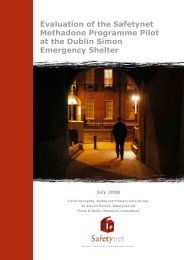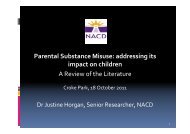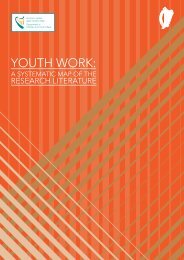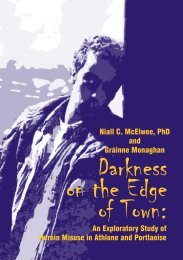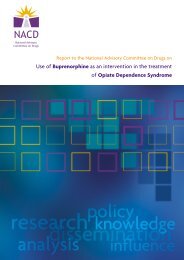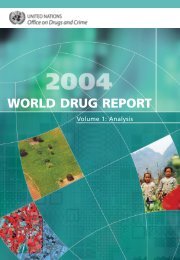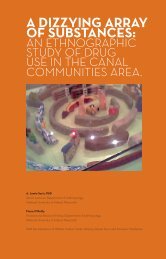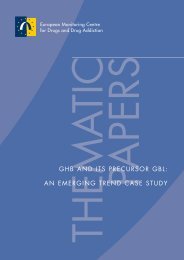Many services offer a comb<strong>in</strong>ation of <strong>the</strong>se <strong>the</strong>rapies, or acted as a l<strong>in</strong>k to providers ofsuch services (such as counsell<strong>in</strong>g). Overall, drug-treatment services were enthusiasticabout <strong>the</strong> benefits of an approach which encompasses both counsell<strong>in</strong>g andcomplementary <strong>the</strong>rapies. Acupuncture was thought to be very useful <strong>in</strong> calm<strong>in</strong>g clientswho presented <strong>in</strong> an agitated or chaotic state and it offered an attractive <strong>in</strong>centive forusers to attend services regularly:It’s not realistic to expect <strong>the</strong>m to sit <strong>in</strong> <strong>the</strong> room with you for an hour, and that. So, we wouldhave sort of a holistic side <strong>in</strong> a sense. We have three of our staff tra<strong>in</strong>ed up <strong>in</strong> acupuncture, sowe’d use acupuncture which helps <strong>in</strong> ano<strong>the</strong>r way. Because aga<strong>in</strong> what I found is that clientsdon’t want to get <strong>in</strong>to massive one-to-ones. They just want to f<strong>in</strong>d a way like to chill out andcome back down, to take some k<strong>in</strong>d of edge off <strong>the</strong>ir comedown. And <strong>the</strong> acupuncture is agreat tool to be able to use because you can get it k<strong>in</strong>d of <strong>in</strong> <strong>the</strong> door and maybe for 5 or 10m<strong>in</strong>utes you get to have some k<strong>in</strong>d of <strong>in</strong>tervention…Clondalk<strong>in</strong>, drug-treatment service (October 2007)Acupuncture doesn’t cure anyth<strong>in</strong>g. But for some people it works very, very well. It doesn’tdo anyth<strong>in</strong>g for o<strong>the</strong>r people. You know? And what I would be suggest<strong>in</strong>g is that if you havegood holistic people that can talk <strong>the</strong> talk, you know <strong>the</strong> word that <strong>the</strong>y use is … placebo,placebo effect you know <strong>in</strong> o<strong>the</strong>r words if <strong>the</strong>y feel it’s go<strong>in</strong>g to do someth<strong>in</strong>g for <strong>the</strong>m, <strong>the</strong>nit will. It also gives people a feel<strong>in</strong>g that <strong>the</strong>re’s someth<strong>in</strong>g for <strong>the</strong>m when <strong>the</strong>y’re go<strong>in</strong>g <strong>the</strong>re.They get someth<strong>in</strong>g out of it, <strong>the</strong>y feel good about it.Tallaght, drug-treatment services (October 2007)Four services reported provid<strong>in</strong>g starter or welcome packs to users, which <strong>in</strong>cludecontact <strong>in</strong>formation for different services, relaxation materials such as lavender oil, arelaxation CD and o<strong>the</strong>r products. The philosophy underp<strong>in</strong>n<strong>in</strong>g <strong>the</strong> welcome pack isto provide users with support tools even if <strong>the</strong>y do not present to services on a regularbasis:So, people are f<strong>in</strong>d<strong>in</strong>g bits <strong>in</strong> this pack you know that’ll work for <strong>the</strong>m, so we f<strong>in</strong>d this is areally useful tool ... because if somebody comes <strong>in</strong> you might not see <strong>the</strong>m aga<strong>in</strong>. They mightbe really paranoid, <strong>the</strong>y might go out th<strong>in</strong>k<strong>in</strong>g I’m a head banger. They might th<strong>in</strong>k <strong>the</strong>y don’tlike <strong>the</strong> place, or people saw <strong>the</strong>m com<strong>in</strong>g <strong>in</strong> you know what I mean, but <strong>the</strong>y go away withthis th<strong>in</strong>g that it looks like <strong>the</strong>y’re go<strong>in</strong>g to college, you know what I mean, so <strong>the</strong>y go awaywith it and <strong>the</strong>y can k<strong>in</strong>d of, later on <strong>the</strong>y might pick up <strong>the</strong> card or play <strong>the</strong> CD…that’s howit works.Ballyfermot, drug-treatment service (October 2007)<strong>Crack</strong> <strong>coca<strong>in</strong>e</strong> <strong>in</strong> <strong>the</strong> Dubl<strong>in</strong> <strong>region</strong>: an evidence base for a crack <strong>coca<strong>in</strong>e</strong> strategy93
Some services were <strong>in</strong> a position to provide complementary <strong>the</strong>rapy such asacupuncture, reiki, art <strong>the</strong>rapy or massage on a daily basis. Essentially, <strong>the</strong>se <strong>the</strong>rapiesoffer clients alternatives to us<strong>in</strong>g drugs, which may aid <strong>the</strong>ir efforts to break up <strong>the</strong>irpattern of drug use. A number of <strong>the</strong>se services had tra<strong>in</strong>ed exist<strong>in</strong>g staff membersto provide <strong>the</strong>rapies; this enabled <strong>the</strong>m to offer clients an immediate response, ra<strong>the</strong>rthan giv<strong>in</strong>g <strong>the</strong>m ano<strong>the</strong>r appo<strong>in</strong>tment for a later date, which <strong>the</strong>y might not attend.However, not all services have <strong>the</strong> staff or resources to provide such <strong>in</strong>terventions.In 2005, <strong>the</strong> Department of Community, Rural and Gaeltacht Affairs funded andevaluated tra<strong>in</strong><strong>in</strong>g courses for 53 frontl<strong>in</strong>e staff and 76 key workers (Crampton 2005).The courses were organised through Merchants Quay Ireland. In 2006 and 2007, <strong>the</strong>HSE <strong>in</strong> conjunction with <strong>the</strong> University of Leeds tra<strong>in</strong>ed 38 counsellors <strong>in</strong> <strong>the</strong> statutoryand voluntary/community sector <strong>in</strong> <strong>the</strong> use of cognitive behaviour cop<strong>in</strong>g skills(CBCS). This tra<strong>in</strong><strong>in</strong>g programme is recognised widely by cl<strong>in</strong>icians and professionals<strong>in</strong> <strong>the</strong> addiction field as <strong>the</strong> most appropriate method available to enhance <strong>the</strong> skill setsrequired by staff work<strong>in</strong>g with stimulant misuse issues. Fur<strong>the</strong>r courses are due to beheld <strong>in</strong> 2008 (Joe Doyle, HSE, personal communication, June 2008).The Department of Community, Rural and Gaeltacht Affairs also funded and evaluateda number of projects that address <strong>coca<strong>in</strong>e</strong> use. A community-based project <strong>in</strong>volv<strong>in</strong>gSt Dom<strong>in</strong>ic’s Community Response Project and Kill<strong>in</strong>arden’s Community AddictionResponse Programme <strong>in</strong> Tallaght was (accord<strong>in</strong>g to <strong>the</strong> evaluators) effective and verygood value for money (Goodbody Economic Consultants 2006). The project caters forproblematic <strong>in</strong>tranasal <strong>coca<strong>in</strong>e</strong> users ma<strong>in</strong>ly, but also treats a small number of crackusers. Interventions used at <strong>the</strong> project <strong>in</strong>clude <strong>the</strong> advertis<strong>in</strong>g of service availability;<strong>the</strong> hold<strong>in</strong>g of project meet<strong>in</strong>gs; a proactive outreach programme; <strong>the</strong> ma<strong>in</strong>tenance ofa helpl<strong>in</strong>e; <strong>the</strong> promotion of relationship build<strong>in</strong>g between service suppliers and clients;<strong>the</strong> use of <strong>in</strong>dividual care plans; <strong>the</strong> provision of <strong>in</strong>dividual counsell<strong>in</strong>g; and <strong>the</strong> use ofcomplimentary <strong>the</strong>rapies. This example of good practice could be applied elsewhere.9.3 Attract<strong>in</strong>g crack users <strong>in</strong>to treatmentSixteen services reported that <strong>the</strong> biggest challenge is attract<strong>in</strong>g crack users <strong>in</strong>totreatment and reta<strong>in</strong><strong>in</strong>g <strong>the</strong>m long enough to achieve long-last<strong>in</strong>g change. Reportedreasons for users’ reluctance to seek treatment <strong>in</strong>clude:1234Users’ scepticism of <strong>the</strong> benefits of treatment, given that <strong>the</strong>re is no medicalsubstitute.Users’ fear of suffer<strong>in</strong>g penalties from <strong>the</strong>ir methadone or employment programmes.Users’ lifestyles be<strong>in</strong>g too chaotic to facilitate <strong>the</strong>m attend<strong>in</strong>g treatment regularly.Users’ perception that crack use is stigmatised, thus discourag<strong>in</strong>g disclosure.94 <strong>Crack</strong> <strong>coca<strong>in</strong>e</strong> <strong>in</strong> <strong>the</strong> Dubl<strong>in</strong> <strong>region</strong>: an evidence base for a crack <strong>coca<strong>in</strong>e</strong> strategy
- Page 1 and 2:
HRB Research Series6Crack cocaine i
- Page 3 and 4:
This publication should be cited as
- Page 5 and 6:
HRB Research Series publicationsto
- Page 8 and 9:
ContentsList of tables and figures
- Page 10 and 11:
7 Social consequences of crack use
- Page 12 and 13:
List of tables and figuresTablesTab
- Page 14 and 15:
AbbreviationsADRUGNDUHRBISCCSGLDTFN
- Page 16 and 17:
Glossary of termsBenzos: The street
- Page 18 and 19:
Executive summaryBackground and stu
- Page 20 and 21:
phone and buyers are directed to sp
- Page 22 and 23:
Part 1IntroductionCrack cocaine in
- Page 24 and 25:
In the light of these concerns, it
- Page 26 and 27:
extensive reporting in the US about
- Page 28 and 29:
Ten interviews were conducted with
- Page 30 and 31:
also offers potential to trace supp
- Page 32 and 33:
Part 2Crack cocaine in the Dublin r
- Page 34 and 35:
2.2 Criminal justice data - cocaine
- Page 36 and 37:
Prevalence of crack use among homel
- Page 38 and 39:
Local survey dataA survey in 2006 o
- Page 40 and 41:
Respondent 1: I’d say it’s stil
- Page 42 and 43:
3 Dublin crack cocaine market3.0 Ov
- Page 44 and 45: sold on the street for as little as
- Page 46 and 47: Like, I was down on M… Street in
- Page 48 and 49: 3.4 Marketing crackFour interviewee
- Page 50 and 51: While crack was generally bought al
- Page 52 and 53: • Although a number of dealers, o
- Page 54 and 55: 4.2 Crack use and genderAccording t
- Page 56 and 57: From about 16 to 21 I would say - t
- Page 58 and 59: Table 4.4Number of new cases who li
- Page 60 and 61: 5.2 Crack and other drugsMany of th
- Page 62 and 63: Whether treated cases reported crac
- Page 64 and 65: cases of intravenous cocaine use, t
- Page 66 and 67: Table 5.5Number (%) of new cases wh
- Page 68 and 69: Part 3Consequences of crack useCrac
- Page 70 and 71: etween heroin, cocaine and crime. T
- Page 72 and 73: So, they would talk about the kind
- Page 74 and 75: Crack and prostitutionNine services
- Page 76 and 77: On the other hand, reports from two
- Page 78 and 79: often with a prevalence of opiate d
- Page 80 and 81: The data provided by the NDTRS in S
- Page 82 and 83: But you know it would be about kind
- Page 84 and 85: So, debt is another significant iss
- Page 86 and 87: 7.6 Key findings• A significant p
- Page 88 and 89: There are considerable long-term ps
- Page 90: 8.3 Psychological consequences of c
- Page 93: 9 Treating crack use9.0 OverviewIn
- Page 97 and 98: Both opiate-dependent and non-opiat
- Page 99 and 100: • more outreach work to identify
- Page 101 and 102: 10 Policing crack markets10.0 Overv
- Page 103 and 104: local communities. There is growing
- Page 105 and 106: He’d know me, I’d know him, you
- Page 107 and 108: Table 10.1 Number of new cases who
- Page 109 and 110: 108 Crack cocaine in the Dublin reg
- Page 111 and 112: 11 Discussion and research implicat
- Page 113 and 114: 11.2 Responding to crack markets an
- Page 115 and 116: 11.3 Reducing the harm that crack c
- Page 117 and 118: Shoplifting, burglary and robbery w
- Page 119 and 120: Bourgois P (2003b) Crack and the po
- Page 121 and 122: Furey M and Browne C (2004) Opiate
- Page 123 and 124: Loughran H and McCann ME (2006) A c
- Page 125 and 126: San Diego Police Department (1998)
- Page 127 and 128: Appendix A:An evidence base for tre
- Page 129 and 130: note that providing information on
- Page 131 and 132: MedicationsA number of studies have
- Page 133 and 134: interpersonal psychotherapy. Americ
- Page 135 and 136: Jurisdiction Intervention/Descripti
- Page 137 and 138: Jurisdiction Intervention/Descripti
- Page 139 and 140: Appendix C:Recent HRB series public
- Page 141 and 142: 140 Crack cocaine in the Dublin reg




